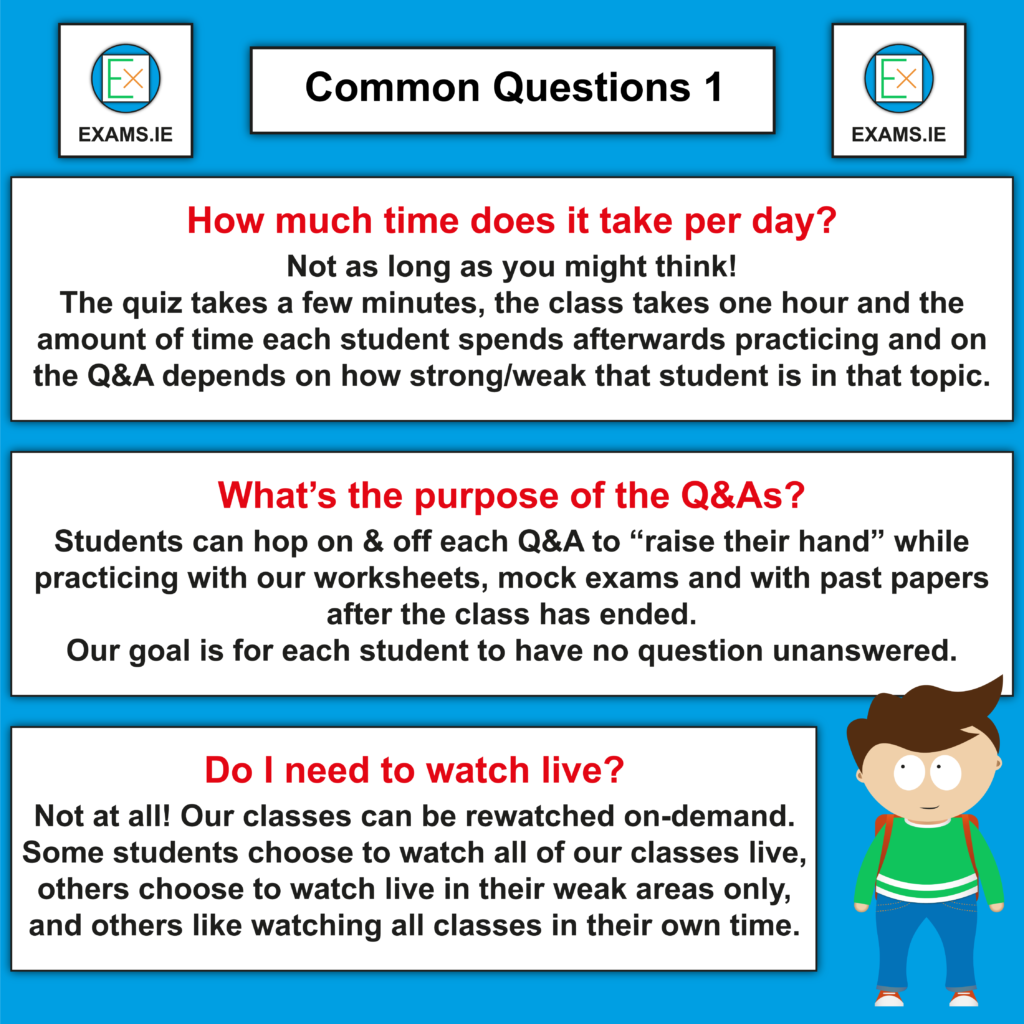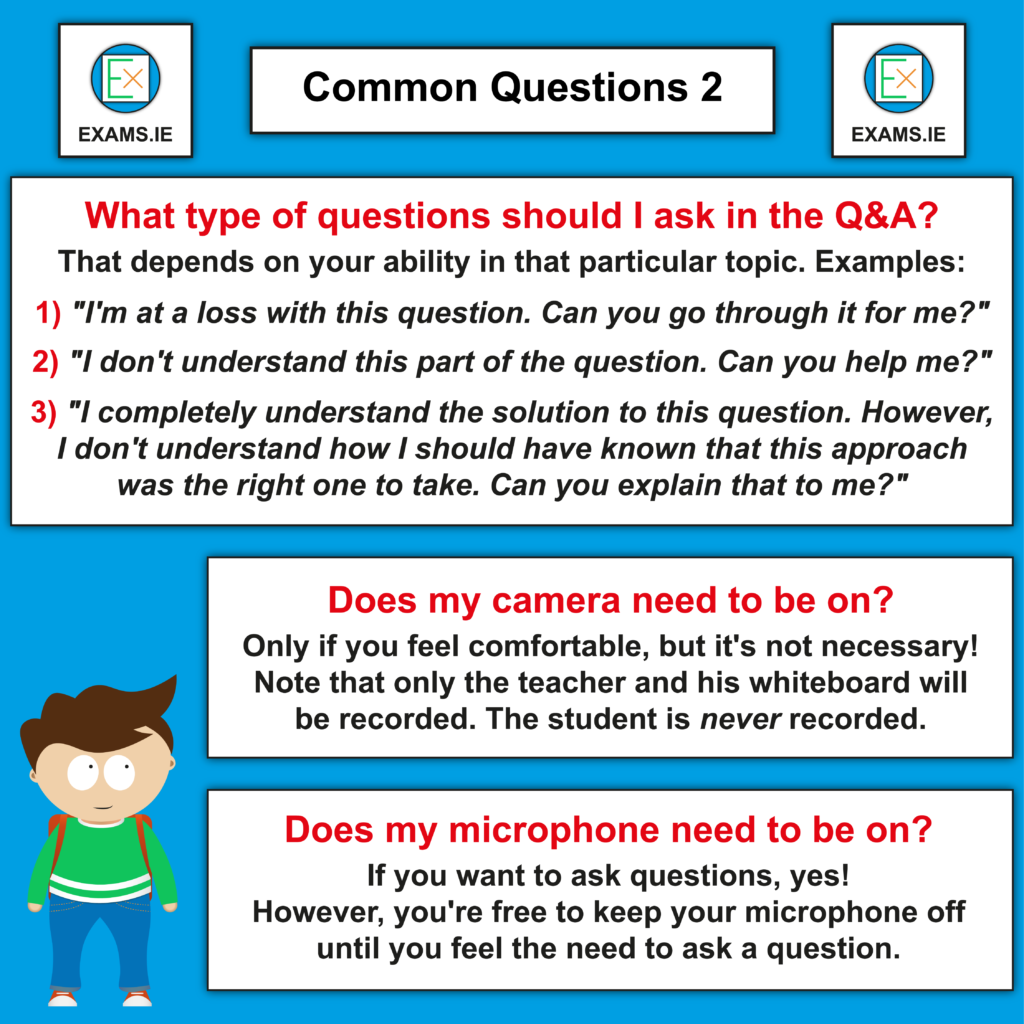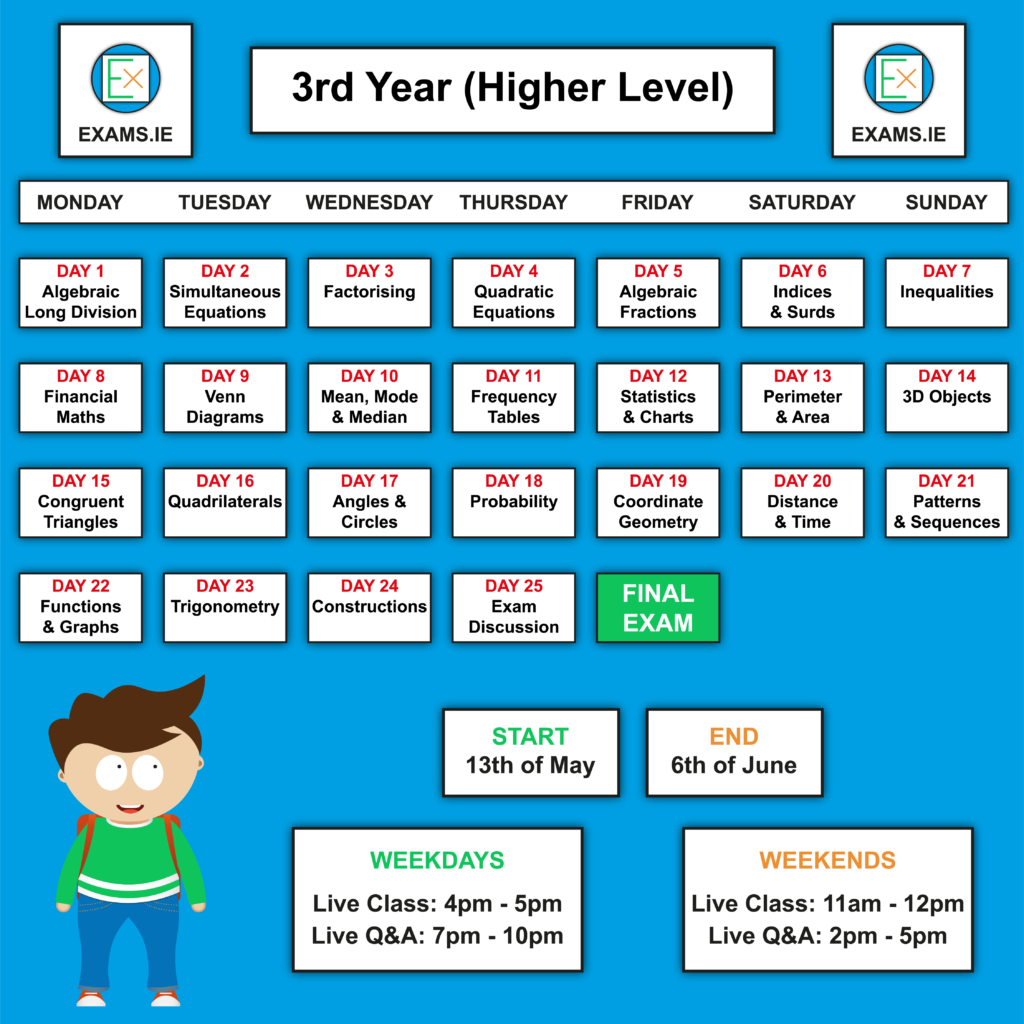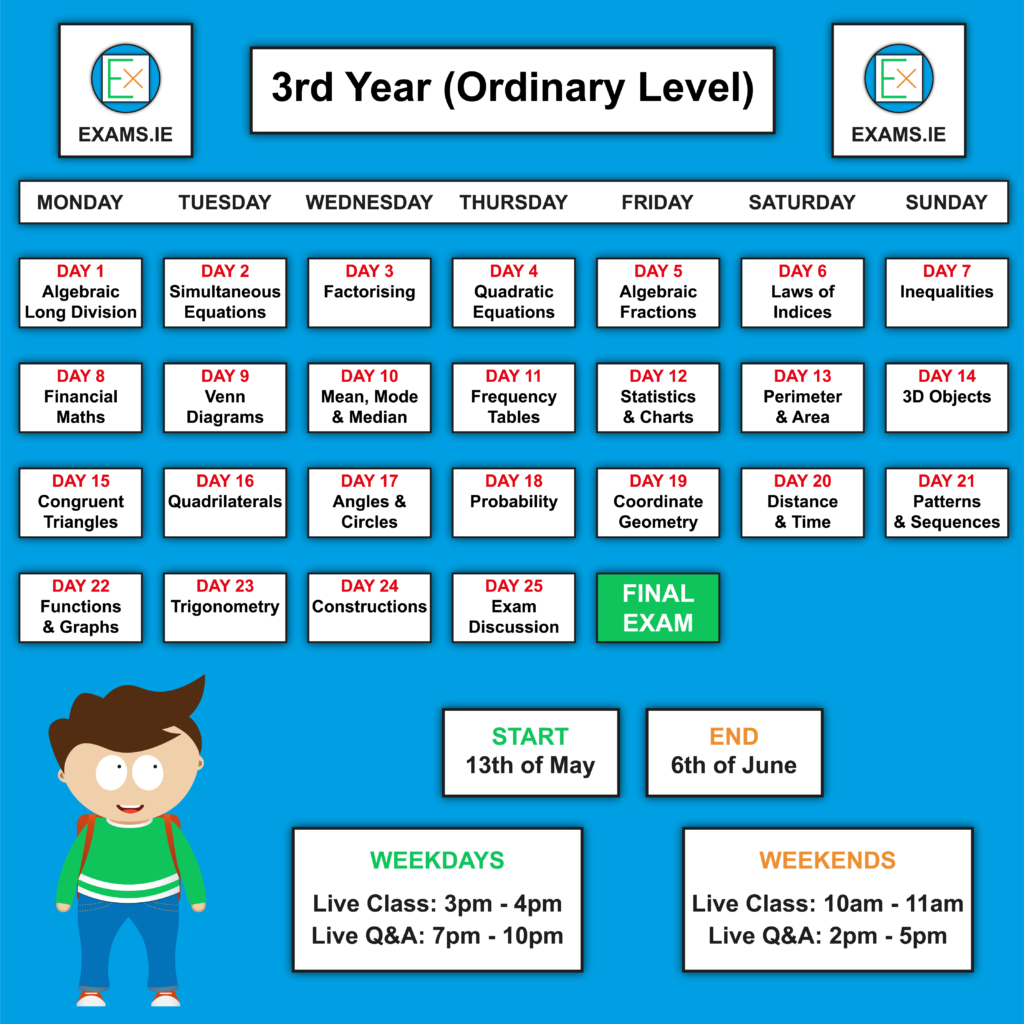HL Mock Exam A
Question 1
Consider the graph of the lines \(l_1\) and \(l_2\) below.
(a) State whether each line has a positive or negative slope.
Answer
\(l_1\) has a positive slope and \(l_2\) has a negative slope.
Solution
\(l_1\) has a positive slope and \(l_2\) has a negative slope.
Video Walkthrough
(b) The equation of the line \(l_1\) is \(y=2x+1\).
(i) Write down the equation of any line that is parallel to \(l_1\).
\(l_1\) passes through the point \((-3,k)\).
(ii) Find the value of \(k\).
Answer
(i) \(y=2x+3\)
(ii) \(k=-5\)
Solution
(i) \(y=2x+3\)
(ii)
\begin{align}k&=2(-3)+1\\&=-5\end{align}
Video Walkthrough
(c) The line \(l_2\) contains the points \(A(3,1)\) and \(B(-4,0)\).
Find \(|AB|\). Write your answer in surd form.
Answer
\(\sqrt{50}\mbox{ units}\)
Solution
\begin{align}|AB|&=\sqrt{(x_2-x_1)^2-(y_2-y_1)^2}\\&=\sqrt{(-4-3)^2+(0-1)^2}\\&=\sqrt{49+1}\\&=\sqrt{50}\mbox{ units}\end{align}
Video Walkthrough
(d) The equation of the line \(l_2\) is \(y=-4x+3\).
Find the intersection point of \(l_1\) and \(l_2\).
Answer
\(\left(\dfrac{1}{3},\dfrac{5}{3}\right)\)
Solution
\begin{align}y=2x+1\end{align}
\begin{align}y=-4x+3\end{align}
\begin{align}\downarrow\end{align}
\begin{align}0=6x-2\end{align}
\begin{align}\downarrow\end{align}
\begin{align}x&=\frac{2}{6}\\&=\frac{1}{3}\end{align}
and
\begin{align}y&=2x+1\\&=2\left(\frac{1}{3}\right)+1\\&=\frac{5}{3}\end{align}
Therefore, the intersection point is \(\left(\dfrac{1}{3},\dfrac{5}{3}\right)\).
Video Walkthrough
Question 2
A class \(U\) of \(25\) students were asked if they own a laptop \(L\) and/or a tablet \(T\).
\(4\) students said that own had a laptop only.
(a) Which of the letters \(A\), \(B\) and \(C\) is therefore equal to \(4\)?
Answer
\(B\)
Solution
\(B\)
Video Walkthrough
(b) We also know that \(60\%\) of the students own a laptop.
Find the number of students who own both a laptop and a tablet.
Answer
\(11\)
Solution
\begin{align}25\times0.6-4=11\end{align}
Video Walkthrough
(c) “\(\#(L’)\) is equal to the number of students who own a tablet only.”
Is this statement correct? Explain why.
Answer
No as \(\#(L’)\) is equal to the number of students who own a tablet only plus the number of students who own neither.
Solution
No as \(\#(L’)\) is equal to the number of students who own a tablet only plus the number of students who own neither.
Video Walkthrough
Question 3
Consider the following inequality:
\begin{align}3-x<1\end{align}
where \(x\in\mathbb{N}\).
(a) State any value of \(x\) which satisfies this inequality.
Answer
\(x=3\)
Solution
\(x=3\)
Video Walkthrough
(b) Solve the inequality.
Answer
\(x>2\)
Solution
\begin{align}3-x<1\end{align}
\begin{align}\downarrow\end{align}
\begin{align}-x<1-3\end{align}
\begin{align}\downarrow\end{align}
\begin{align}-x<-2\end{align}
\begin{align}\downarrow\end{align}
\begin{align}x>2\end{align}
Video Walkthrough
(c) “If we allowed \(x\) to be integers rather than just natural numbers, the solution to the inequality would still be the same.”
Explain why this statement is correct.
Answer
Since \(x>2\), only positive integers, i.e. natural numbers, are possible values of \(x\).
Solution
Since \(x>2\), only positive integers, i.e. natural numbers, are possible values of \(x\).
Video Walkthrough
Question 4
Jacob wishes to travel from \(A\) to \(B\) by car.
However, there is no direct route from \(A\) to \(B\).
Instead, he must travel \(1.2 \mbox{ km}\) from \(A\) to \(C\), turn \(90^{\circ}\) left at \(C\) and then travel \(700\mbox{ m}\) from \(C\) to \(B\).
(a) Find the distance Jacob will travel in his car. Write your answer in kilometers.
Answer
\(1.9\mbox{ km}\)
Solution
\begin{align}d&=1.2+0.7\\&=1.9\mbox{ km}\end{align}
Video Walkthrough
(b) Find the straight-line distance between \(A\) and \(B\). Write your answer in metres correct to two decimal places.
Answer
\(1{,}389.24\mbox{ m}\)
Solution
\begin{align}|AB|&=\sqrt{1.2^2+0.7^2}\\&=1.389244…\mbox{ km}\\&\approx1{,}389.24\mbox{ m}\end{align}
Video Walkthrough
(c) Calculate the angle \(\theta\) in the diagram above. Give your answer in degrees, correct to the nearest degree.
Answer
\(60^{\circ}\)
Solution
\begin{align}\tan\theta=\frac{1.2}{0.7}\end{align}
\begin{align}\downarrow\end{align}
\begin{align}\theta&=\tan^{-1}\left(\frac{1.2}{0.7}\right)\\&\approx60^{\circ}\end{align}
Video Walkthrough
(d) Jacob’s journey ended up taking a total of \(1.2\) minutes.
Find Jacob’s average speed for the journey. Write your answer in kilometres per hour.
Answer
\(95\mbox{ km/hr}\)
Solution
\begin{align}s&=\frac{d}{t}\\&=\frac{1.9}{1.2/60}\\&=95\mbox{ km/hr}\end{align}
Video Walkthrough
Question 5
Consider the following shape.
(a) Find an expression for the perimeter of this shape in terms of \(x\). Write this expression in the form \((a+\sqrt{b})x\), where \(a,b,\in\mathbb{N}\).
Answer
\((4+\sqrt{2})x\)
Solution
\begin{align}P&=2x+x+x+\sqrt{x^2+x^2}\\&=4x+\sqrt{2}x\\&=(4+\sqrt{2})x\end{align}
Video Walkthrough
(b) The area of this shape is \(14\mbox{ units}^2\).
Find the value of \(x\). Write your answer correct to two decimal places.
Answer
\(3.06\mbox{ units}\)
Solution
\begin{align}A=14\end{align}
\begin{align}\downarrow\end{align}
\begin{align}x^2+\frac{1}{2}x^2=14\end{align}
\begin{align}\downarrow\end{align}
\begin{align}\frac{3}{2}x^2=14\end{align}
\begin{align}\downarrow\end{align}
\begin{align}x&=\sqrt{\frac{28}{3}}\\&\approx3.06\mbox{ units}\end{align}
Video Walkthrough
Question 6
(a) Consider the following expression:
\begin{align}8x^2-18y^2\end{align}
(i) If \(x=-3\) and \(y=1\), work out the value of the value of the expression.
(ii) Fully factorise the expression.
Answer
(i) \(54\)
(ii) \(2(2x+3y)(2x-3y)\)
Solution
(i)
\begin{align}8x^2-18y^2&=8(-3)^2-18(1^2)\\&=54\end{align}
(ii)
\begin{align}8x^2-18y^2&=2(4x^2-9y^2)\\&=2[(2x)^2-(3y)^2]\\&=2(2x+3y)(2x-3y)\end{align}
Video Walkthrough
(b) Solve the following equation:
\begin{align}2x^2+5x-3=0\end{align}
Answer
\(x=\dfrac{1}{2}\) or \(x=-3\)
Solution
\begin{align}2x^2+5x-3=0\end{align}
\begin{align}\downarrow\end{align}
\begin{align}(2x-1)(x+3)=0\end{align}
\begin{align}\downarrow\end{align}
\(2x-1=0\) or \(x+3=0\)
\begin{align}\downarrow\end{align}
\(x=\dfrac{1}{2}\) or \(x=-3\)
Video Walkthrough
Question 7
Brandon purchased a video games console for \(300\mbox{ euro}\).
(a) This selling price included VAT at \(23\%\).
Find the VAT that Brandon paid. Write your answer correct to the nearest cent.
Answer
(i) The Conjugate Roots theorem cannot be used as the coefficients of the equation are not all real.
(ii) \(z_2=-i\)
Solution
\begin{align}\mbox{VAT}&=300\frac{300}{1.23}\\&=56.10\mbox{ euro}\end{align}
Video Walkthrough
(b) \(1\mbox{ euro}=160\mbox{ yen}\).
Find the selling price of the console in yen.
Answer
\(48{,}000\mbox{ yen}\)
Solution
\begin{align}300\times160=48{,}000\mbox{ yen}\end{align}
Video Walkthrough
(c) The console depreciates in value by \(15\%\) each year.
(i) Find the value of the console \(5\) years after Brandon purchased it, correct to the nearest cent.
(ii) Find the percentage loss Brandon would make if he sold it at this depreciated value at the end of the 5th year, correct to the nearest percent.
Answer
(i) \(133.11\mbox{ euro}\)
(ii) \(56\%\)
Solution
(i)
\begin{align}300(0.85)^5\approx133.11\mbox{ euro}\end{align}
(ii)
\begin{align}\frac{300-133.11}{300}\times100\approx56\%\end{align}
Video Walkthrough
Question 8
Below are the ages (in years) of everyone in a small classroom (including the teacher!):
\begin{align}12&&11&&12&&10&&12&&10&&38\end{align}
(a) Find the range of these ages.
Answer
\(28\mbox{ years}\)
Solution
\begin{align}38-10=28\mbox{ years}\end{align}
Video Walkthrough
(b) Which of the seven values would be considered an outlier?
Answer
\(38\)
Solution
\(38\)
Video Walkthrough
(c) Find the mean of these ages.
Answer
\(15\mbox{ years old}\)
Solution
\begin{align}\frac{12+11+12+10+12+10+38}{7}=15\mbox{ years old}\end{align}
Video Walkthrough
(d) Explain why the mean would be a bad choice to measure the average in this case.
Answer
Six of the seven data values are less than the mean.
Solution
Six of the seven data values are less than the mean.
Video Walkthrough
Question 9
The first three terms of a sequence are as follows:
\begin{align}11,15,19\end{align}
(a) Is this sequence linear, quadratic or exponential?
Answer
Linear
Solution
Linear
Video Walkthrough
(b) What is the next term in the sequence?
Answer
\(23\)
Solution
\(23\)
Video Walkthrough
(c) \(T_n\) refers to the \(n\)th term of a sequence.
(i) Write an expression for \(T_n\) for this sequence.
(ii) Using part (i), or otherwise, find the value of \(n\) for the term \(103\) in the sequence.
Answer
(i) \(T_n=4n+7\)
(ii) \(24\)
Solution
(i) \begin{align}T_n&=11+4n-4\\&=4n+7\end{align}
(ii)
\begin{align}T_n=103\end{align}
\begin{align}\downarrow\end{align}
\begin{align}4n+7=103\end{align}
\begin{align}\downarrow\end{align}
\begin{align}n&=\frac{103-7}{4}\\&=24\end{align}
Video Walkthrough
Question 10
Three tennis balls of radius \(7\mbox{ cm}\) are placed inside their cylindrical container as shown.
(a) Find the surface area of one of the tennis balls. Write your answer in terms of \(\pi\).
Answer
\(196\pi\mbox{ cm}^2\)
Solution
\begin{align}A&=4\pi r^2\\&=4\pi(7^2)\\&=196\pi\mbox{ cm}^2\end{align}
Video Walkthrough
No gap is left between the top of the highest tennis ball and the top of the container.
(b) Find the height of the container.
Answer
\(42\mbox{ cm}\)
Solution
\begin{align}h&=6r\\&=6(7)\\&=42\mbox{ cm}\end{align}
Video Walkthrough
(c) Find the volume of the container. Write your answer correct to \(1\) decimal place.
Answer
\(6465.4\mbox{ cm}^3\)
Solution
\begin{align}V&=\pi r^2h\\&=\pi(7^2)(42)\\&\approx6465.4\mbox{ cm}^3\end{align}
Video Walkthrough
(d) Find the volume of air in the container. Give your answer correct to one deicmal place.
Answer
\(2155.1\mbox{ m}^3\)
Solution
\begin{align}V&=6465.4-3\left(\frac{4}{3}\pi r^3\right)\\&=6465.4-4\pi(7^3)\\&\approx2155.1\mbox{ m}^3\end{align}





